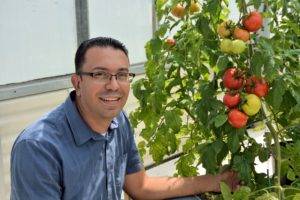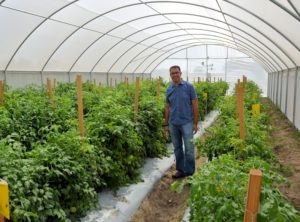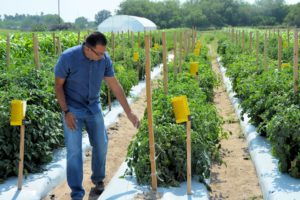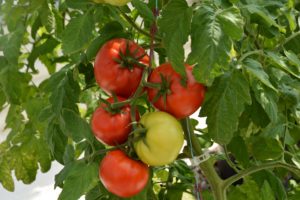Welasco, Texas, USA
May 25, 2016
To help revive the state’s sagging vegetable industry, Texas A&M AgriLife Research scientists in South Texas are looking at new cropping systems to improve and extend the tomato growing season.
While the Rio Grande Valley’s fertile soils can produce tasty tomatoes for consumers, the harsh conditions of heat, insects and diseases can stand in the way, said Dr. Carlos Avila, an AgriLife Research vegetable breeder at the Texas A&M AgriLife Research and Extension Center at Weslaco.

Dr. Carlos Avila, a Texas A&M AgriLife Research vegetable breeder in Weslaco, is shown in a greenhouse with tomato plants from his improved cultivar studies. (AgriLife Communications photo by Rod Santa Ana)
“We’re working on developing adapted cultivars for South Texas, but we’re also developing production systems to optimize and fully exploit their potential,” he said.
By evaluating varieties best suited to the area and how best to grow them, Avila said growers will be able to efficiently produce high-quality tomatoes that can be profitable for them.
“We’re working to develop production systems, especially covered structures, in order to improve the yield and quality of tomato crops,” he said.
https://youtu.be/yWSXVZRtg0w
Avila said he is evaluating and comparing the use of greenhouses, high tunnels and net houses to determine the best alternative to open field production, which provides no protection from the harsh South Texas elements.
“We’re evaluating 10 different varieties in each of those three structures to compare yield, pest incidence and fruit quality,” he said.

Dr. Carlos Avila is shown in a net house, one of three structures being studied to improve production of commercial tomatoes in South Texas. Because they are evaluated for retaining heat, high tunnels will be erected and studied this winter. (AgriLife Communications photo by Rod Santa Ana)
High tunnels are Quonset hut-type structures similar to greenhouses in appearance but lack artificial heating or cooling, Avila said. They are semi-temporary structures covered with a single layer of greenhouse-grade plastic to provide protection against the rain.
Net houses are relatively low-investment, sealed structures completely covered with insect net designed to physically keep insects away from plants.
Each has pros and cons, Avila said.
“Net houses do not provide a physical barrier to rain, but they allow better airflow compared to high tunnels and therefore extend the production season under high temperatures,” he said. “Greenhouses, which are the most expensive of these structures, provide ultimate weather control due to their heating and cooling systems and can reduce the weather variability we see here in the Valley within the growing season.”
As opposed to growing tomatoes in open fields, Avila said any of the covered structures provide an alternative to the harsh environmental conditions here.
“They can all extend the growing season and allow production during winter, early summer and late fall,” he said. “Plus, they provide a physical barrier that reduces pest pressure and the cosmetic effects of wind damage.”

Avila evaluates tomatoes grown in Weslaco in open field conditions, which exposes them to the Rio Grande Valley’s harsh growing conditions. A net house can be seen in the background. (AgriLife Communications photo by Rod Santa Ana)
Growing commercial tomatoes in covered structures also allows growers to produce tomatoes when pests and disease infestation and inoculum are low, Avila said.
“In this way, covered structures allow us to reduce pest and disease incidence by both physical and seasonal exclusion,” he said. “They also increase marketing opportunities, improve early cash flow, increase marketable yield, improve fruit quality and they often result in a reduction of pesticide applications.”
Unfortunately, Avila said, due to the highly variable climatic conditions and the relatively short growing season of South Texas, no single covered structure is feasible for all seasons.

Dr. Avila’s tomatoes are seen in a greenhouse, a structure that provides the most environmental control but is also the most expensive of the three he’s studying. (AgriLife Communications photo by Rod Santa Ana)
“It’s already obvious that no single production system can meet all needs, so a combination of the three protected structures may be required for those producers who want to produce year round,” he said.
To optimize yield potential and increase profits, Avila said a multi-system approach may be the answer to protect tomato varieties from environmental conditions.
“It’s also obvious at this point that any of the three structures provide protection from damage resulting from excessive hail, wind and heat units,” he said. “How to optimize a profitable yield potential will include cost analysis and economic feasibility studies that are part of this project and will be conducted by Dr. Samuel Zapata, the Texas A&M AgriLife Extension Service economist here in Weslaco.”
In addition to evaluating covered structures to improve the state’s vegetable production, Avila and his AgriLife colleagues in Weslaco and College Station are also developing superior tomato and spinach cultivars and studying insect-vector transmitted diseases.
“It’s all part of AgriLife’s dedication and efforts to revive the state’s vegetable industry that has been in decline for years,” Avila said. “In the case of tomatoes, production was nearly wiped out in the Rio Grande Valley by insects and diseases that were not around in the 1960s and 70s when production was thriving here.”
Production dropped from 36,000 acres to only about 800 acres today, he said. Texas is now a net importer of about 2.4 billion pounds of tomatoes annually.
John Sharp, Texas A&M University System chancellor, said, “Being a net importer of vegetables is not only unacceptable, it’s un-Texan.”